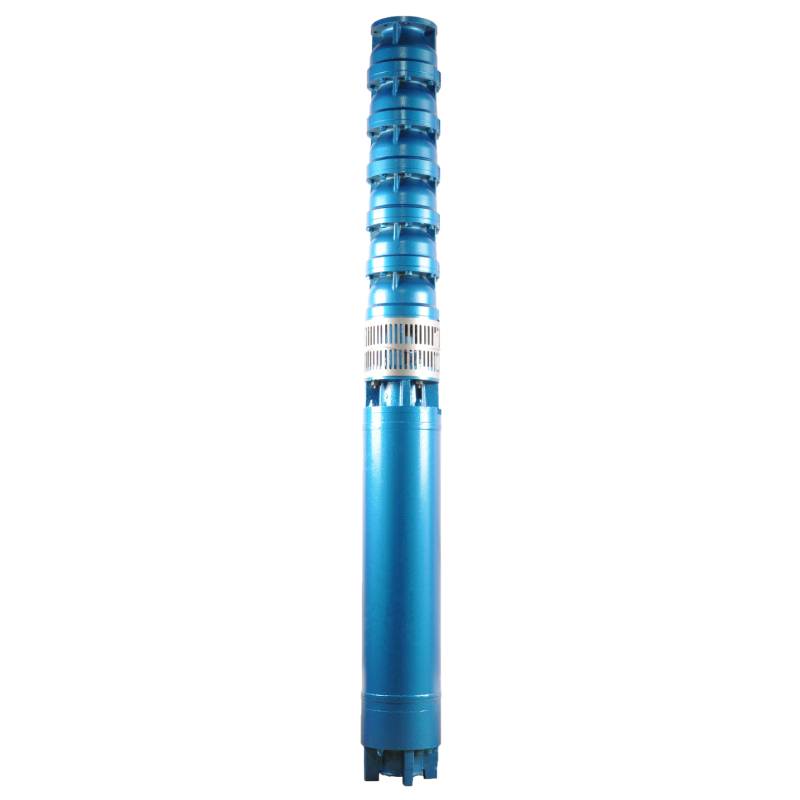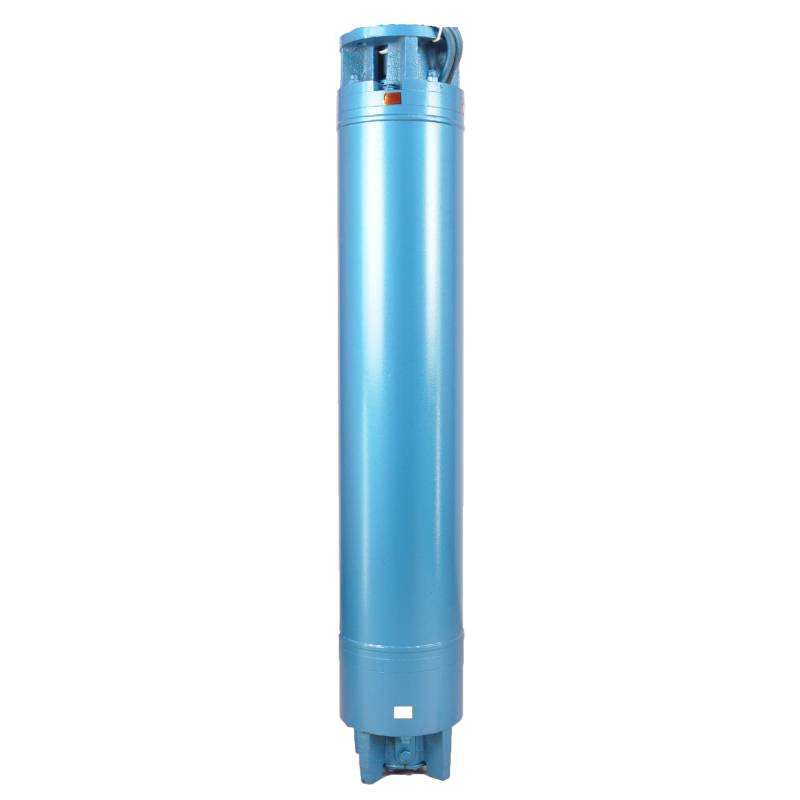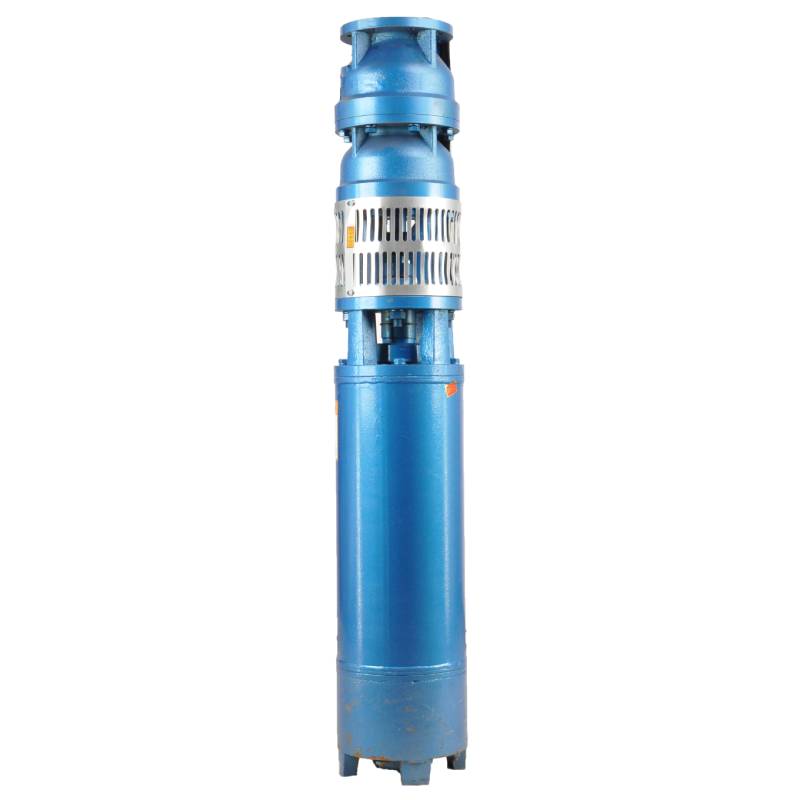The product adopts special waterproof wire design, which can realize long-term stable conversion operation of the motor within the frequency range of 1HZ-50HZ. The frequency conversion winding design not only makes the frequency conversion deep well pump more energy saving, but also prolongs its service life. The motor winding adopts special water-resistant conductors that are resistant to high frequency impact, pulse peak voltage impact and high temperature aging, with excellent characteristics and stability.
The product is powered by three-phase AC 380V power supply, 50HZ frequency, suitable for the environment with harsh water quality conditions. Specific requirements include water temperature below 20 °C, solid impurities content is not greater than 0.01%, PH value is 6.5-8.5, hydrogen sulfide content is not greater than 1.5mg/L, chloride ion content is not greater than 400mg/L. The product adopts closed or water immersion structure of the motor, before use to ensure that the pump is fully filled with water, no-load test run is strictly prohibited. The pump must be completely immersed in water, not more than 70m water depth, water source to meet the requirements of the pump water output and continuous operation. In addition, the well must be vertical, the pump can only be used vertically. The wiring should be supported according to the requirements, and equipped with external overload protection device. This series of requirements to ensure the efficient and stable operation of the product, suitable for all kinds of special environment of the pump demand.
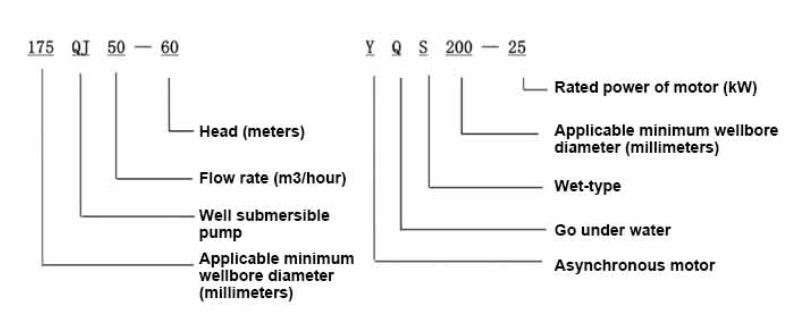
| Mohlala | Phallo (m3/h) | Hlooho (m) |
Rotatingspeed (fetola/ ntlha) |
Pompo ea metsi(%) | Sethala bophara (mm) |
E sebetsa hantle bophara(mm) |
E lekantsoe power(KW) |
E lekantsoe motlakase (V) |
E lekantsoe jwale (A) |
Monyetla (%) | power factorcosφ | Yuniti Radial Maximu size(mm) |
Ela hloko | |||||||||
| 250QJ50-40 | 50 | 40 | 2875 | 72 | 80 | 250hodimo | 9.2 | 380 | 21.7 | 78.5 | 0.82 | 233 | ||||||||||
| 250QJ50-60 | 60 | 13 | 30.1 | 80.0 | 0.82 | |||||||||||||||||
| 250QJ50-80 | 80 | 18.5 | 40.8 | 82.0 | 0.84 | |||||||||||||||||
| 250QJ50-100 | 100 | 22 | 47.9 | 83.0 | 0.84 | |||||||||||||||||
| 250QJ50-120 | 120 | 25 | 53.8 | 84.0 | 0.84 | |||||||||||||||||
| 250QJ50-140 | 140 | 30 | 64.2 | 84.5 | 0.84 | |||||||||||||||||
| 250QJ50-160 | 160 | 37 | 77.8 | 85.0 | 0.85 | |||||||||||||||||
| 250QJ50-200 | 200 | 45 | 94.1 | 85.5 | 0.85 | |||||||||||||||||
| 250QJ50-240 | 240 | 55 | 114.3 | 86.0 | 0.85 | |||||||||||||||||
| 250QJ50-280 | 280 | 63 | 131.0 | 86.0 | 0.85 | |||||||||||||||||
| 250QJ50-320 | 320 | 75 | 152.3 | 87.0 | 0.86 | |||||||||||||||||
| 250QJ50-400 | 400 | 90 | 182.8 | 87.0 | 0.86 | |||||||||||||||||
| 250QJ50-440 | 440 | 100 | 203.1 | 87.0 | 0.86 | |||||||||||||||||
| 250QJ63-40 | 63 | 40 | 2875 | 74 | 80 | 250hodimo | 11 | 380 | 25.8 | 79.0 | 0.82 | 233 | ||||||||||
| 250QJ63-60 | 60 | 18.5 | 40.8 | 82.0 | 0.84 | |||||||||||||||||
| 250QJ63-80 | 80 | 22 | 47.9 | 83.0 | 0.84 | |||||||||||||||||
| 250QJ63-100 | 100 | 30 | 64.2 | 84.5 | 0.84 | |||||||||||||||||
| 250QJ63-120 | 120 | 37 | 77.8 | 85.0 | 0.85 | |||||||||||||||||
| 250QJ63-160 | 160 | 45 | 94.1 | 85.5 | 0.85 | |||||||||||||||||
| 250QJ63-200 | 200 | 55 | 114.3 | 86.0 | 0.85 | |||||||||||||||||
| 250QJ63-220 | 220 | 63 | 131.0 | 86.0 | 0.85 | |||||||||||||||||
| 250QJ63-260 | 260 | 75 | 152.3 | 87.0 | 0.86 | |||||||||||||||||
| 250QJ63-300 | 300 | 90 | 182.8 | 87.0 | 0.86 | |||||||||||||||||
| 250QJ63-360 | 360 | 100 | 203.1 | 87.0 | 0.86 | |||||||||||||||||
| 250QJ80-20 | 80 | 20 | 2875 | 75 | 100 | 250hodimo | 7.5 | 380 | 18.0 | 78.0 | 0.81 | 233 | ||||||||||
| 250QJ80-40 | 40 | 15 | 33.9 | 81.0 | 0.83 | |||||||||||||||||
| 250QJ80-60 | 60 | 22 | 47.9 | 83.0 | 0.84 | |||||||||||||||||
| 250QJ80-80 | 80 | 30 | 64.2 | 84.5 | 0.84 | |||||||||||||||||
| 250QJ80-100 | 100 | 37 | 77.8 | 85.0 | 0.85 | |||||||||||||||||
| 250QJ80-120 | 120 | 45 | 94.1 | 85.5 | 0.85 | |||||||||||||||||
| 250QJ80-160 | 80 | 160 | 2875 | 75 | 100 | 250hodimo | 55 | 380 | 114.3 | 86.0 | 0.85 | 233 | ||||||||||
| 250QJ80-180 | 180 | 63 | 131.0 | 86.0 | 0.85 | |||||||||||||||||
| 250QJ80-200 | 200 | 75 | 152.3 | 87.0 | 0.86 | |||||||||||||||||
| 250QJ80-240 | 240 | 90 | 182.8 | 87.0 | 0.86 | |||||||||||||||||
| 250QJ80-280 | 280 | 100 | 203.1 | 87.0 | 0.86 | |||||||||||||||||
| 250QJ100-18 | 100 | 18 | 2875 | 75 | 100 | 250hodimo | 7.5 | 380 | 18.0 | 78.0 | 0.81 | 233 | ||||||||||
| 250QJ100-36 | 36 | 15 | 33.9 | 81.0 | 0.83 | |||||||||||||||||
| 250QJ100-54 | 54 | 25 | 53.8 | 84.0 | 0.84 | |||||||||||||||||
| 250QJ100-72 | 72 | 30 | 64.2 | 84.5 | 0.84 | |||||||||||||||||
| 250QJ100-90 | 90 | 37 | 77.8 | 85.0 | 0.85 | |||||||||||||||||
| 250QJ100-108 | 108 | 45 | 94.1 | 85.5 | 0.85 | |||||||||||||||||
| 250QJ100-126 | 126 | 55 | 114.3 | 86.0 | 0.85 | |||||||||||||||||
| 250QJ100-144 | 144 | 63 | 131.0 | 86.0 | 0.85 | |||||||||||||||||
| 250QJ100-162 | 162 | 75 | 152.3 | 87.0 | 0.86 | |||||||||||||||||
| 250QJ100-198 | 198 | 90 | 182.8 | 87.0 | 0.86 | |||||||||||||||||
| 250QJ100-216 | 216 | 100 | 203.1 | 87.0 | 0.86 | |||||||||||||||||
| 250QJ125-16 | 125 | 16 | 2875 | 76 | 125 | 250hodimo | 9.2 | 380 | 21.7 | 78.5 | 0.82 | 233 | ||||||||||
| 250QJ125-32 | 32 | 18.5 | 40.8 | 82.0 | 0.84 | |||||||||||||||||
| 250QJ125-48 | 48 | 25 | 53.8 | 84.0 | 0.84 | |||||||||||||||||
| 250QJ125-64 | 64 | 37 | 77.8 | 85.0 | 0.85 | |||||||||||||||||
| 250QJ125-80 | 80 | 45 | 94.1 | 85.5 | 0.85 | |||||||||||||||||
| 250QJ125-96 | 96 | 55 | 114.3 | 86.0 | 0.85 | |||||||||||||||||
| 250QJ125-112 | 112 | 63 | 131.0 | 86.0 | 0.85 | |||||||||||||||||
| 250QJ125-128 | 128 | 75 | 152.3 | 87.0 | 0.86 | |||||||||||||||||
| 250QJ125-160 | 160 | 90 | 182.8 | 87.0 | 0.86 | |||||||||||||||||
| 250QJ125-176 | 176 | 100 | 203.1 | 87.0 | 0.86 | |||||||||||||||||
| 250QJ125-192 | 192 | 110 | 219.6 | 87.5 | 0.87 | |||||||||||||||||
| 250QJ140-15 | 140 | 15 | 2875 | 76 | 125 | 250hodimo | 9.2 | 380 | 21.7 | 78.5 | 0.82 | 233 | ||||||||||
| 250QJ140-30 | 30 | 18.5 | 40.8 | 82.0 | 0.84 | |||||||||||||||||
| 250QJ140-45 | 45 | 30 | 64.2 | 84.5 | 0.84 | |||||||||||||||||
| 250QJ140-60 | 60 | 37 | 77.8 | 85.0 | 0.85 | |||||||||||||||||
| 250QJ140-75 | 45 | 45 | 94.1 | 85.5 | 0.85 | |||||||||||||||||
| 250QJ140-90 | 90 | 55 | 114.3 | 86.0 | 0.85 | |||||||||||||||||
| 250QJ140-105 | 140 | 105 | 2875 | 76 | 125 | 250hodimo | 63 | 380 | 131.0 | 86.0 | 0.85 | 233 | ||||||||||
| 250QJ140-120 | 120 | 75 | 152.3 | 87.0 | 0.86 | |||||||||||||||||
| 250QJ140-150 | 150 | 90 | 182.8 | 87.0 | 0.86 | |||||||||||||||||
| 250QJ140-165 | 165 | 100 | 203.1 | 87.0 | 0.86 | |||||||||||||||||
| 250QJ140-180 | 180 | 110 | 219.6 | 87.5 | 0.87 | |||||||||||||||||
| 250QJ200-20 | 200 | 20 | 2875 | 75 | 150 | 250hodimo | 18.5 | 380 | 40.8 | 82.0 | 0.84 | 233 | ||||||||||
| 250QJ200-40 | 40 | 37 | 77.8 | 85.0 | 0.85 | |||||||||||||||||
| 250QJ200-60 | 60 | 55 | 114.3 | 86.0 | 0.85 | |||||||||||||||||
| 250QJ200-80 | 80 | 75 | 152.3 | 87.0 | 0.86 | |||||||||||||||||
| 250QJ200-100 | 100 | 90 | 182.8 | 87.0 | 0.86 | |||||||||||||||||
| 250QJ200-120 | 120 | 100 | 203.1 | 87.0 | 0.86 | |||||||||||||||||
| 250QJ200-140 | 140 | 125 | 249.5 | 87.5 | 0.87 | |||||||||||||||||
1, well submersible pump for clean water pump, prohibit the new well, pumping sediment and muddy water,
2, well water pump voltage grade of 380/50HZ, the use of other voltage grades of submersible motors need to be customized. The underground cable must use waterproof cable, must be equipped with starting equipment, such as distribution box, start not ready should have commonly used motor comprehensive protection function, such as short circuit overload protection, phase protection, undervoltage protection, grounding protection, idling protection, in case of abnormal conditions, the protection device should be timely action trip.
3, the installation and use of the pump must be reliably grounded, prohibit the push and pull switch when the hands and feet are wet, the installation and maintenance of the pump must be cut off the power supply, the use of the pump place to set up "to prevent electric shock" obvious signs:
4, down the well or before installation, the motor cavity must be filled with distilled water or non-corrosive clean cold boiling water, tighten the / water bolt, the pump on the ground test run, must be to the pump chamber water lubrication rubber bearings, instant start not more than a second, see whether the steering is the same as the steering instructions. When the pump is upright, pay attention to safety, prevent overturning injury.
5, ho latela lipehelo tsa phahamiso ea pompo, mefuta e fapaneng ea ts'ebeliso ea phallo, ho thibela phallo e tlase kapa matla a ho pompa a phahamiso e phahameng, matla a ho pompa le likarolo tse ling tsa moaparo, moroalo o moholo oa koloi o chesitsoe.
6, after the pump down the well, the measurement of the motor to the ground insulation resistance should not be less than 100M, after the start to observe the voltage and current, check the motor winding insulation, whether in line with the requirements; pump storage location temperature if less than freezing point, should be dry the motor cavity water, prevent the motor cavity water ice damage caused by low temperature.
The pump parts are mainly composed of pump shaft, impeller, shunt shell, rubber bearing, check valve body and so on; the motor part mainly includes base, pressure regulating diaphragm, thrust bearing, thrust plate, lower guide bearing seat, stator, rotor, upper guide bearing seat, sand discharging ring, water inlet section, cable lead, etc. The main characteristic of the product is that the motor is a water-filled wet submersible three-phase asynchronous motor, the motor cavity is filled with water, used to cool the motor and lubricate the bearing; the pressure regulating diaphragm at the bottom is used to adjust the expansion and contraction pressure difference of the internal water caused by the change of the temperature rise of the motor. In order to prevent the sand particles in the well water from entering the motor, two sand sealing rings are installed on the upper end of the motor shaft extension, and a sand discharging ring is installed to form a sand prevention structure. To prevent the pump shaft from jumping when starting up, the pump shaft is connected with the motor shaft through a coupling, and the thrust bearing is installed on the lower part of the motor. The motor and pump bearing adopt water lubrication technology, and the stator winding of the motor adopts high quality submersible motor winding with high insulation performance. The pump is designed by computer CAD, with simple structure and excellent technical performance.

(1) Tokisetso pele ho ho kenya:
1. Lekola hore na pompo e ka tlas'a metsi e kopana le maemo a ts'ebeliso le boholo bo boletsoeng bukeng ea tataiso.
2. Ho sebelisa obiect e boima e nang le bophara bo lekanang le bophara bo boholo ba ka ntle ba pompo e ka tlas'a metsi, lekanya hore na inneldiameter ea seliba e ka lumellana le pompo e ka tlas'a metsi, 'me u lekanye hore na botebo ba seliba bo finyella litlhoko tsa ho kenya.
3. Lekola hore na seliba se hloekile le hore na metsi a seliba a litšila. Le ka mohla u se ke ua sebelisa pompo ea motlakase e ka tlas'a metsi ho hlatsoa seretse sa pompo ea welor le metsi a lehlabathe ho qoba tšenyo ea pele ho nako ea pompo ea motlakase e ka tlase ho metsi.
4. Sheba hore na boemo ba letlapa la ho kenya welhead le loketse le hore na le khona ho mamella boleng ba yuniti kaofela.
5. Sheba hore na likarolo tsa pompo tse ka tlas'a metsi li phethehile 'me li kentsoe ka nepo ho ea ka setšoantšo sa kopano se bukeng ea litaelo Tlosa skrine ea sefe 'me u potolohe sekopanyi ho bona hore na se potoloha ka mokhoa o bonolo.
6. Hlakola sekoti sa metsi 'me u tlatse lesoba la motlakase ka metsi a hloekileng, a sa cheng (hlokomela. etsa bonnete ba hore u se tlatse), ebe u tiisa sekheo sa metsi. Kamora lihora tse 12 tsa ente ea metsi, khanyetso ea enjene ha ea lokela ho ba ka tlase ho 150M Q ha e lekantsoe ka tafole ea 500V e sisinyehang.
7. Cable joint, cut off a 120mm rubber sleeve from one end of the outgoing cable and the matching cable with an electrician's knifethen stagger the length of the three core wires in a stepped shape, peel off a 20mm copper core, scrape of the oxide layer on theoutside of the copper wire with a knife or sand cloth, and insert the two connected wire ends in palirs.After tying the layer tightly with fine copper wire, solder it thoroughly and firmly, and sand of any. burrs on the surface. Then, forthe three joints, use polyvester insulation tape to wrap them in a semi stacked manner for three lavers. Wrap the two ends of thewrapping layer tightywith nyion thread,and then use a semi stacked method to wrap the tape for three layers. Wrap the outellayer with high-pressure insulation tape for three layers. Finally, fold the threestrands together and repeatedly wrap them for fivelayers with high-pressure tape. Each layer must be tightly tied, and the interlayer joints must be tight and fimm to prevent water frompenetrating and damaging the insulation, After wrapping, soak in water at room temperature of 20 ’c for 12 hours, and measurethe insulation resistance with a shaking table, which should not be less than 100M Ω
Sets'oants'o sa ts'ebetso ea terata ea cable e kenyellelitsoeng ka tsela e latelang: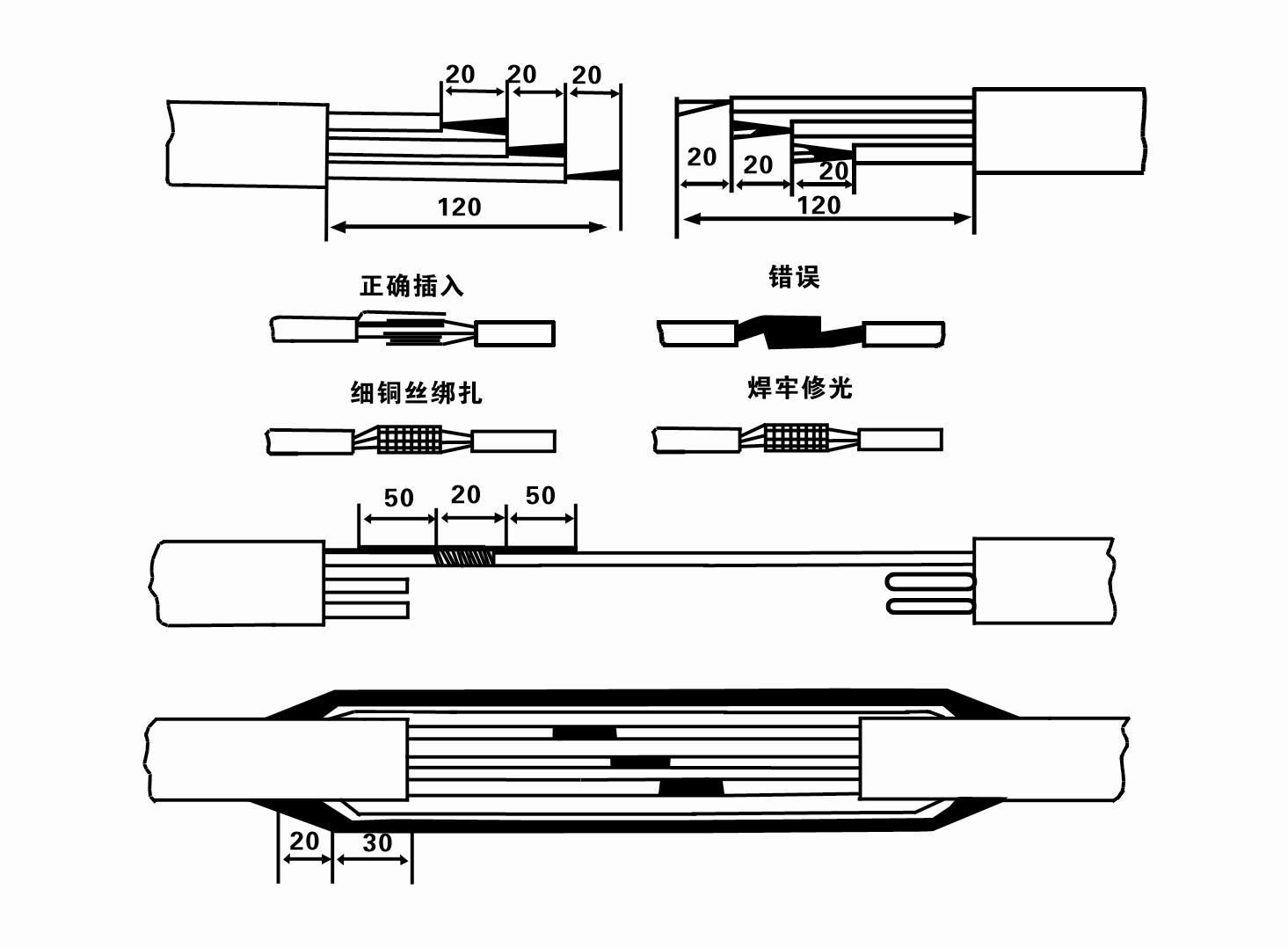
8. Sebelisa multimeter ho hlahloba hore na lithapo tsa mekhahlelo e meraro li hokahane le hore na ho hanyetsa ha DC ho batla ho leka-lekana.
9. Lekola hore na matla a potoloho le a transformer a tletse, ebe o hokahanya sesebelisoa sa ts'ireletso ea overload kapa lisebelisoa tsa ho qala. Sheba Tafole ea 2 bakeng sa mefuta e ikhethileng, ebe u tšela bakete ea metsi ka har'a pompo ea metsi ho tsoa sebakeng sa pompo ea metsi ho tlotsa li-bearings tsa rabara ka har'a pompo, ebe u beha pompo ea motlakase e ka tlas'a metsi e otlolohile ebile e tsitsitse. Qala (e seng ho feta motsotsoana) 'me u hlahlobe hore na tataiso ea tsamaiso e lumellana le letšoao la ho tsamaisa. Haeba ho se joalo, fapanyetsana lihokelo leha e le life tse peli tsa mohala oa mekhahlelo e meraro. Ebe u kenya filthara 'me u itokisetse ho theohela selibeng. Haeba e sebelisoa liketsahalong tse khethehileng (tse kang liforo, liforo, linōka, matangoana, matangoana, joalo-joalo), pompo ea motlakase e tlameha ho thehoa ka mokhoa o tšepahalang.
(2) Lisebelisoa le lisebelisoa tsa ho kenya:
1. Para e le 'ngoe ea liketane tse phahamisang lithane tse fetang tse peli.
2. Tripod e nang le bophahamo bo otlolohileng bo sa feteng limithara tse 'nè.
3. Liropo tse peli tse leketlileng (lithapo tsa terata) tse ka jarang boima ba lithane tse fetang e le 'ngoe (li ka jara boima ba sete e felletseng ea lipompo tsa metsi).
4. Kenya lipara tse peli tsa li-clamp (li-splints).
5. Li-wrenches, lihamore, screwdrivers, lisebelisoa tsa motlakase le lisebelisoa, joalo-joalo.
(3) Ho kenya pompo ea motlakase:
1. Setšoantšo sa ho kenya pompo ea motlakase e ka tlas'a metsi e bontšoa ho Setšoantšo sa 2. Litekanyo tse khethehileng tsa ho kenya li bontšoa ho Lethathamo la 3 "Lethathamo la Litekanyo tsa ho Kenyeletsoa ha Pompo ea Motlakase ea Submersible".
2. Lipompo tsa motlakase tse ka tlas’a metsi tse nang le hlooho e ka tlaase ho limithara tse 30 li ka phahamisoa ka ho toba selibeng ho sebelisa liphaepe le lithapo tsa terata kapa lithapo tse ling tsa hemp tse ka khonang ho jara boima bo feletseng ba mochine kaofela, lipeipi tsa metsi, le metsi a liphaephe.
3. Lipompo tse nang le hlooho ea limithara tse fetang 30 li sebelisa liphaephe tsa tšepe, 'me tatellano ea ho kenya e tjena:
① Sebelisa clamp ho tiisa ntlha e ka holimo ea karolo ea pompo ea metsi (enjene le pompo ea metsi li se li hokahantsoe ka nako ena), e phahamise ka ketane e leketlileng, 'me butle-butle e e tlamelle ka selibeng ho fihlela u Beha thipa holim'a seliba ebe u tlosa ketane e leketlileng.
② Sebelisa para e 'ngoe ea li-clamp ho tlamella phala, u e phahamise ka ketane e leketlileng e bolelele ba lisenthimithara tse 15 ho tloha flange, 'me u e theole butle. Pakeng tsa peipi flange le pompo flange Beha pete ea rabara sebakeng 'me u tiise phala 'me u pompe ka ho lekana ka liboutu, linate le lihlatsoana tsa selemo.
③ Phahamisa pompo e ka tlas'a metsi hanyenyane, tlosa sekoti karolong e ka holimo ea pompo ea metsi, tlamella thapo ka thata peiping ea metsi ka tepi ea polasetiki, 'me u e tlamele butle ho fihlela Sekoti se behoa selibeng.
④ Sebelisa mokhoa o tšoanang ho fasa lipeipi tsohle tsa metsi selibeng.
⑤Ka mor'a hore thapo e etellang pele e hokahane le sesebelisoa sa taolo, e hokahane le phepelo ea motlakase ea mekhahlelo e meraro.
(4) Lintho tseo u lokelang ho li ela hloko nakong ea ho kenya:
1. Haeba ketsahalo ea jamming e fumanoa nakong ea ho pompa, fetola kapa u hule phala ea metsi ho hlōla ntlha ea ho jamming. Haeba mehato e fapaneng e ntse e sa sebetse, ka kopo U se ke ua qobella pompo hore e theohe ho qoba tšenyo ea pompo ea motlakase e ka tlas'a metsi le seliba.
2. Nakong ea ho kenya, pente ea rabara e lokela ho behoa ka lehlakoreng la phala e 'ngoe le e' ngoe 'me e tiisetsoe ka tsela e tšoanang.
3. Ha pompo ea metsi e theoleloa ka selibeng, e lokela ho behoa bohareng ba phala ea seliba ho thibela pompo ho matha leboteng la seliba nako e telele, ho etsa hore pompo e thothomele le motor e fiele le ho chesa. .
4. Etsa qeto ea botebo ba pompo ea metsi ho ea tlaase ho seliba ho ea ka lehlabathe le phallang le maemo a silt a seliba. U se ke ua pata pompo ka seretseng. Sebaka ho tloha pompong ea metsi ho ea tlase ho seliba hangata ha se ka tlase ho limithara tse 3 (sheba setšoantšo sa 2).
5. Botebo ba ho kena ha metsi ba pompo ea metsi ha boa lokela ho ba tlase ho limithara tse 1-1.5 ho tloha boemong ba metsi a matla ho ea ho node ea metsi (sheba setšoantšo sa 2). Ho seng joalo, li-bearings tsa pompo ea metsi li ka senyeha habonolo.
6. Phahamiso ea pompo ea metsi e ke ke ea ba tlase haholo. Ho seng joalo, belofo ea heke e hloka ho kenngoa pompong ea metsi ea seliba ho laola phallo ea pompo sebakeng sa phallo e lekantsoeng ho thibela enjene hore e se ke ea tlala le ho cha ka lebaka la likhahla tse kholo tsa phallo.
7. Ha pompo ea metsi e ntse e sebetsa, tlhahiso ea metsi e lokela ho ba e tsoelang pele esita le, hona joale e lokela ho ba e tsitsitseng (tlas'a maemo a sebetsang a lekantsoeng, ka kakaretso ha a na ho feta 10% ea hona joale e lekantsoeng), 'me ha hoa lokela ho ba le ho thothomela kapa lerata. Haeba ho na le ntho e sa tloaelehang, mochine o lokela ho emisoa ho fumana sesosa le ho o felisa.
8. Ha u kenya, ela hloko boemo ba mohala oa motlakase oa motlakase (sheba setšoantšo sa 2). Ha phala ea metsi e le phala ea tšepe, e etelle pele ho tloha ho clamp ea seliba; ha phala ea metsi e le phala ea polasetiki, e etelle pele ho tloha letšoao la motheo la pompo ea motlakase.
- 1.After the submersible pump is installed, check the insulation resistance and three-phase conduction from the switch again, check whether the instrument and the connection of the start 2.equipment are wrong, if there is no problem, the trial machine can be started, and observe whether the indicator readings of the instrument exceed the rated voltage and current specified on 3.the nameplate after the start, and observe whether the pump has noise and vibration phenomenon, and put into operation if everything is normal.
- 4.After the first operation of the pump for four hours, the motor should be shut down to test the thermal insulation resistance quickly, and its value should not be less than 0.5 megaohm.
- 5.After the pump is shut down, it should be started after five minutes to prevent the water column in the pipe from being completely reflowed and causing excessive motor current and burnout.
- 6.After the pump is put into normal operation, in order to prolong its service life, it is necessary to check whether the supply voltage, working current and insulation resistance are normal regularly. If the following conditions are found, the pump should be shut down immediately to troubleshoot.
- 1 In the rated condition, the current exceeds 20%.
- 2 Boemo ba metsi a matla bo theohela karolong e kenang ea metsi, e bakang metsi a nakoana.
- 3 Pompo e ka tlas'a metsi e na le ho thothomela ho matla kapa lerata.
- 4 Matla a phepelo a tlase ho feta 340 volts.
- 5 Fuse e chesitsoe ka mollo.
- 6 Peipi ea phepelo ea metsi e senyehile.
- 7 The motor's thermal insulation resistance is lower than 0.5 megaohm.
- Unit disassembly:
- 1 Untie the cable tie, remove the pipeline part, and remove the wire plate. 2 screw down the water bolt, put the water in the motor chamber.
- 3 tlosa filthara, lokolla screw e tsitsitseng holim'a coupling ho lokisa shaft ea motor.
- 4 fafatsa bolt e kopanyang karolo e kenang ea metsi le enjene, 'me u arole pompo ho enjene (ela hloko cushion ea yuniti ha u arohana, ho thibela ho kobeha ha shaft ea pompo)
- 5 tatellano ea disassembly ea pompo ke: (sheba setšoantšo sa 1) karolo ea ho kenya metsi, impeller, khetla ea ho kheloha, impeller...... hlahloba 'mele oa valve, ha u tlosa mochine, sebelisa lisebelisoa tse khethehileng ho lokolla letsoho la conical la e tsitsitseng. impeller pele, 'me u qobe ho khumama le ho senya pompo ea pompo nakong ea ho qhaqhoa.
- 6 ts'ebetso ea ho qhaqhoa ha enjene ke: (sheba setšoantšo sa 1) beha enjene sethaleng, 'me u tlose linate, botlaaseng, nate ea hlooho ea shaft, thrust plate, senotlolo, setulo se ka tlase sa tataiso le bolt ea hlooho e habeli ho tloha tlase ho motlakase ka lehlakoreng le leng, ebe o ntša rotor (ela hloko hore u se ke ua senya sephutheloana sa terata) 'me qetellong u tlose karolo e kopanyang le setulo se ka holimo sa tataiso.
- Kopano ea lihlopha tse 7: pele ho kopano, mafome le litšila tsa likarolo li lokela ho hloekisoa, 'me bokaholimo ba ho kopanya le li-fasteners li koahetsoe ka sealant, ebe li bokelloa ka tatellano e fapaneng ea disassembly (mochine oa motlakase o ea holimo le tlaase ka mor'a kopano hoo e ka bang e le' ngoe. millimeter), ka mor'a kopano, coupling e lokela ho ba e tenyetsehang, ebe mochine oa tlhahlobo ea skrine oa filthara. Lipompompo tse ka tlas'a metsi li tla ntšoa ka selibeng bakeng sa ho qhaqha le ho hlokomeloa ho latela Article 5 ka mor'a selemo sa ts'ebetso, kapa ka tlase ho selemo sa ts'ebetso empa lilemo tse peli tsa nako ea ho qoela, 'me likarolo tse tsofetseng li tla nkeloa sebaka.
In order to ensure the long-term use and stable performance of submersible electric pump, we have launched a convenient and practical product. The product has a unique design, easy operation, and is perfect for various application scenarios. After use, remember to discharge all the water in the electric pump, especially in winter, so as not to freeze the motor. Wind the cable and bundle it. Store it in an environment without corrosive substances and gases, and keep the temperature below 40 °C. In addition, if you do not use it for a long time, you should pay attention to prevent the submersible electric pump from rusting. Choose our products to make your work more convenient and efficient.
- Impeller
- Sleeve sa Shaft
- Mokotla oa rabara
-
Lesale la ho tiisa
01 Ho noa metsi a seliba se tebileng
02 Phepelo ea metsi e phahameng
03 phepelo ea metsi thabeng
04 metsi a tora
05 Ho nosetsa ka temo
06 ho nosetsa serapeng
07 ho noa metsi a noka
08 metsi a malapeng

